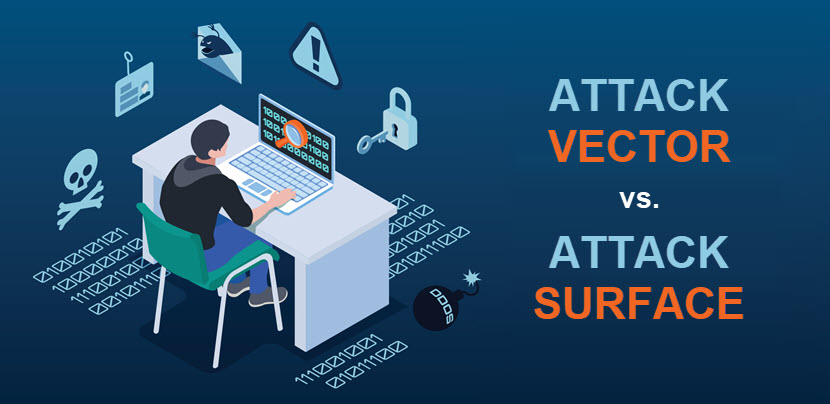A hacker uses several types of cyber attacks to gain access to a network. Cyber attacks use different attack vectors to identify and exploit network vulnerabilities. This way, hackers access a wide range of sensitive data and personal information.
This article provides a detailed overview of attack vectors and discusses the differences between them and attack surfaces. Besides offering a head-to-head attack vector vs. surface comparison, we provide recent examples and discuss the most common ways criminals breach systems.

Attack Vector vs. Attack Surface: What Are They?
An attack vector is a cyber attack that exploits system vulnerabilities so a hacker can illegally access a network to obtain sensitive information and use it to their advantage. The primary purpose of a cyber attack is financial gain.
Attack surface relates to the total number of attack vectors a hacker can use to access or extract data from a network or a computer system. The total number of vulnerabilities a hacker can exploit limits an attack surface - for example, the number of access points, data extraction points, or exposed system elements.
An attack vector data breach is when an unauthorized individual or a group of individuals access sensitive, protected, or confidential data. A data breach costs organizations over $4 million on average, which is why investments in the cybersecurity industry are on the rise.
Digital forensics prevents the information stolen from being used for illegal activity. At the same time, IP attribution attempts to identify the user or device that committed the attack, or at least the geographical location. However, IP attribution techniques are becoming increasingly ineffective, as hackers easily cloak IP addresses, use a shared IP address, or commit attacks from public networks.
Read our article about the differences between public and private IP addresses.
Attack Vector Explained
Attack vectors enable hackers to commit a wide range of malicious activities. There are two types of attack vector exploits:
- Passive attack vector exploits.
- Active attack vector exploits.
Passive vs. Active Attack Vectors
A passive attack vector exploit aims to create an access point on a network. This allows hackers to steal information, but no other malicious or damaging activity occurs.
An active attack vector exploit, however, makes changes to a network or system as part of a longer-term strategy.
Active attack vector exploits include:
- Malware.
- Ransomware.
- Email spoofing.
- Man-in-the-Middle (Eavesdropping) attacks.
- Domain hijacks.
Common Types of Attack Vectors
A simple attack vector targets an organization’s network to steal personal information that has monetary value. This includes credit card numbers and banking details.
However, many attacks are much more complex and include sophisticated methods for gaining unauthorized access.
Unauthorized Remote Access Using Malware
One highly sophisticated attack vector is tricking users into downloading malware. Once executed, this software grants remote access to the victim’s computer or network. Groups of cybercriminals can conduct this attack vector on a large scale to gain remote access to thousands of devices and establish a Robot Network (or BotNet).
Once established, a BotNet can conduct all kinds of cybercrimes, from phishing scams to illegal mining of crypto tokens.
Distributed Denial of Service (DDoS) Attacks
Another type of attack vector is a Denial of Service (DDoS) attack. DDoS attacks aim to overload a website or network with countless requests, ultimately causing the network to crash, resulting in downtime.
Other types of attack vectors include:
- Cross-Site Scripting (XSS).
- Session hijacking.
- Trojans.
- SQL injections.
- Brute force attacks.
Example of an Attack Vector
Symbiote, a Linux malware designed to target the financial sector in Latin America, was discovered in November 2021. This malware was said to be “almost impossible” to detect. The malware granted attackers remote access to networks, provided rootkit functionality, and allowed them to steal credentials.
This attack vector differed from other known Linux malware. Instead of a standalone executable file, Symbiote is a shared object (SO) library that infects all running processes on a machine.

How to Prevent Attack Vectors
We are witnessing a continual growth in the variation of cyberthreats posed to global networks. Hackers easily identify unpatched vulnerabilities via dedicated resources on the Dark Web or by checking Common Vulnerabilities and Exposures (CVE) databases.
Unfortunately, each threat poses a unique challenge, and a one-size-fits-all cyber security solution is not viable. Attack vectors are also becoming more advanced and frequent, requiring constant monitoring and prevention.
Most large organizations across all sectors employ cybersecurity services to protect their and their client’s data. Traditional security measures, such as firewalls, are ineffective against most modern attacks. Therefore, many businesses have moved towards cloud security, hybrid environments, and using intrusion detection systems.

Attack Surface Explained
An attack surface refers to the number of entry points on an IT network that hackers can target to gain access to data. To combat this, many organizations have heavily invested in attack surface monitoring and analytics to identify how large their network’s risk level is.
Below is a closer look at the three types of attack surfaces.
Physical Surface
This attack refers to a malicious threat actor entering buildings, such as offices or data centers, and physically performing illegal activities on a device.
For example, this method includes installing malware on a machine or accessing databases to obtain sensitive information.
Digital Surface
A digital attack surface relates to entry points accessible via the internet - servers, databases, remote devices, etc. The growth of remote working and cloud systems has increased the number of potential vulnerabilities. Therefore, it is crucial to limit your organization’s attack surface to be in a better position to fend off attacks.
Human Surface
Finally, a human attack surface relates to targeting individuals within a business, most commonly, employees of the organization. Social engineering attacks, such as phishing, are a common form of a human attack surface. Therefore, it is very important to train and educate employees to identify malicious activities easily.
Attack Vector vs. Attack Surface: Conclusion
The article explained that an attack vector is a cyber attack that targets vulnerabilities on a network. On the other hand, an attack surface refers to the number of potential vulnerabilities and access points. Attack vectors are becoming increasingly more advanced and have led to a significant rise in cybersecurity funding to help keep information safe.
Constant monitoring, employee training, and using the latest endpoint protection is the best way to defend against cybercrime. However, as attack vectors become more sophisticated, so must preventive measures.




